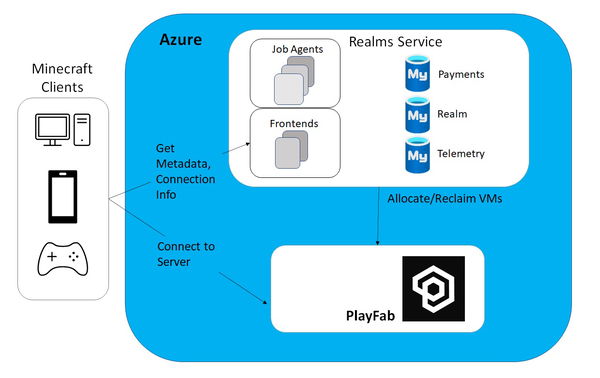

Minecraft Realms is Mojang’s way of allowing people to have their own private servers. Through the means of a monthly subscription priced at $7.99, Realms allows up to 10 players to have their personal world in Minecraft to play together. What most may not know is that there have been major changes made to the game’s backend. To be more specific, the servers have now migrated from Amazon Web Services to Microsoft’s Azure.
Watch What’s Trending Now!
You may wonder ‘how does this directly affect Minecraft’s gameplay?’ or ‘what are its implications?’ Fortunately, there are answers to both these questions.
To understand how it affects the Minecraft gameplay, we need to understand how exactly the migration has gone down. To make it easier to understand, Microsoft’s official developer’s blog breaks down the process into two phases:
ADVERTISEMENT

Imago
Source: Microsoft
Basically, this means that the multiplayer servers were the first ones to make the shift towards Azure. These are the individual player servers for every single Realm. With this shift going towards Azure PlayFab servers, life is now easier for developers. PlayFab allows developers to take complete control over the game in terms of analytics, transactions, and management.
Also Read: Call of Duty League: H3CZ’s Los Angeles Spot Up for Grabs
ADVERTISEMENT
Phase 2 of Migration
In phase 2, the databases, storage, etc. shifted to Azure to complete the process. Take a look at the different services used for the same process, below:
ADVERTISEMENT
Database Migration: Pre-Migration, disparate MySQL databases on AWS were used to catalog user world metadata. The Minecraft team leveraged the Azure Database Migration Service (DMS) to replicate data from Amazon RDS MySQL instances to Azure Database for MySQL .
Storage Migration: The Minecraft team aimed to lift-and-shift the user world data from AWS S3 buckets to Azure Blob Storage. Leveraging AzCopy, they were able to bulk copy data from the source AWS S3 to Azure Storage using simple scripts.
Top Stories
Chiefs Announce Relocation From Missouri to Kansas to Build New Stadium

Is Philip Rivers Catholic or Mormon? Religion, Ethnicity & More About Colts QB

Kansas City Mayor Sends Strong Message to Clark Hunt After Chiefs Confirm Arrowhead Exit

LIV Golf Issues Statement as Pro Announces Shock Retirement After Getting Relegated

DK Metcalf Awaits Huge Punishment From NFL After Controversial Incident vs Detroit Lions

Another Almost Fatal Disaster Surfaces From Statesville Airport Amidst Ongoing Greg Biffle’s Crash Investigation

Compute Migration: Minecraft’s service code used to run entirely on AWS EC2 instances. To initiate the migration, a customized Linux VM image was created by modifying a standard library Linux image with necessary dependencies. The custom image was subsequently loaded to Azure Virtual Machine Scale Sets (VMSS). Finally, the Realms service code was deployed to the VMSS instances at startup time.
ADVERTISEMENT
With this process completed, the Minecraft Realms is now completely hosted and managed by Azure. Take a look at the figure below to see what the current architecture now looks like:

Imago
Source: Microsoft
Now comes the second part- What does this migration imply? Popular industry analyst Daniel Ahmad has a rather simple yet elaborate explanation of this.
ADVERTISEMENT
4) Microsoft owns Azure pic.twitter.com/8EBM8QUcEj
— Daniel Ahmad (@ZhugeEX) October 5, 2020
This is all part of Microsoft's play to position itself across all parts of the game industry value chain.
Not just be a developer of games for its own platforms, but enable developers to utilise the same tools it does to build and operate games too, with a benefit to Xbox.
— Daniel Ahmad (@ZhugeEX) October 5, 2020
ADVERTISEMENT
Implications of Minecraft Realms’ shift from AWS to Azure
The last bit is the one where the majority of focus should be. Microsoft already owns Mojang, which means that Minecraft is already a part of its family. It is a great decision to migrate Realms from AWS to Azure because it gives more control to Microsoft over the game and its services. Additionally, this also proves an important point about Azure’s global reach and how it is a great option for developers to host their games.
Moreover, the entire migration process explained above also serves an important purpose. It shows the developers how easy it can be to move to a better hosting service that makes life easier for them. Azure, clubbed with PlayFab, is the cherry on top, as it is specifically designed to enable developers to take complete control of their games, hassle-free.
It may even seem like Microsoft is trying to sell its service to other developers, and rightfully so.
ADVERTISEMENT
Lastly, this also cements an important point which states that Azure’s global reach is greater than most of its competitors. Not only does this help Microsoft’s cause in terms of sales, but also allows the developers to ensure less latency on their servers. Surely Microsoft has big plans for other games too and is well on its way to being a part of every service offering in the industry.
ADVERTISEMENT
ADVERTISEMENT
ADVERTISEMENT

